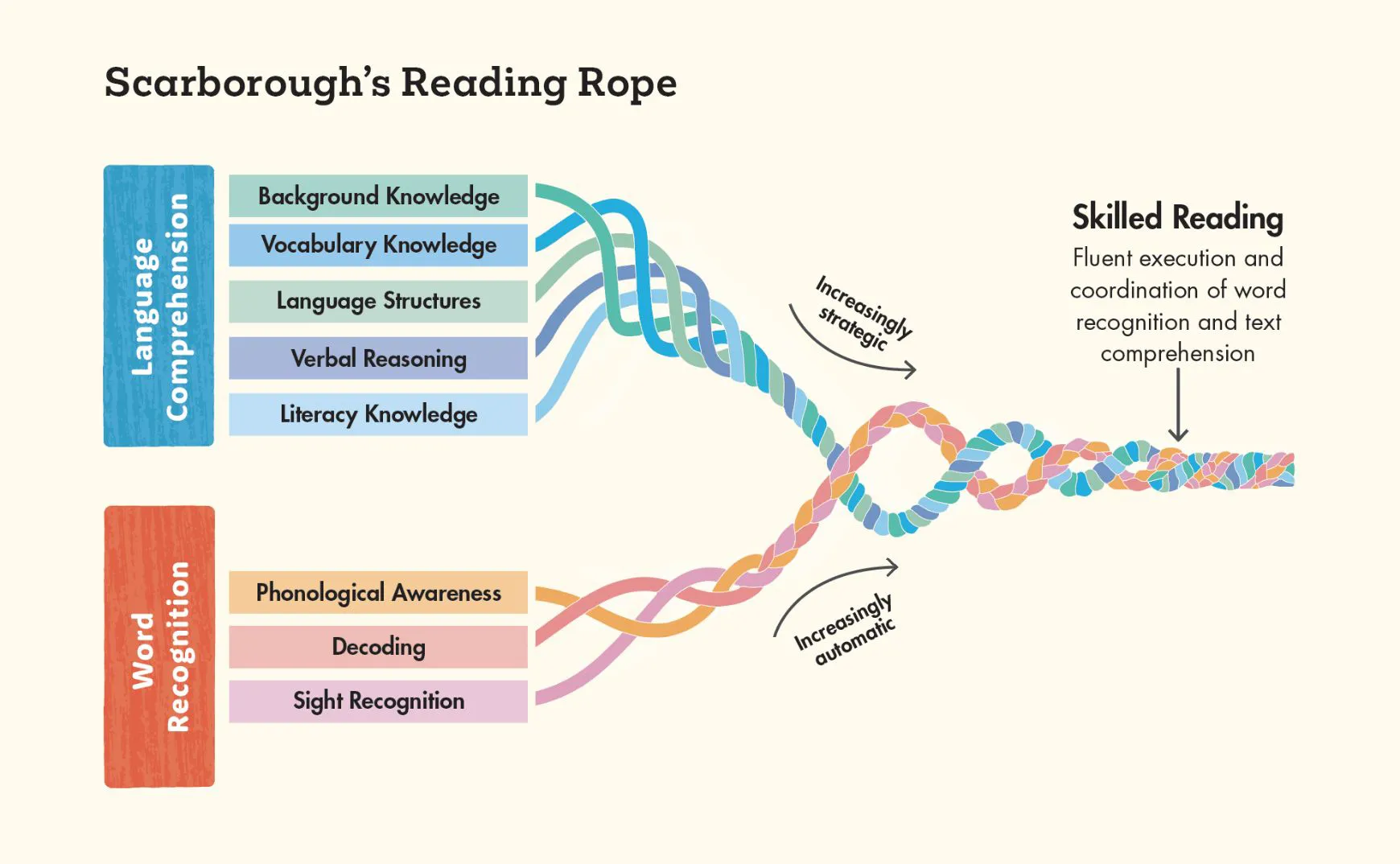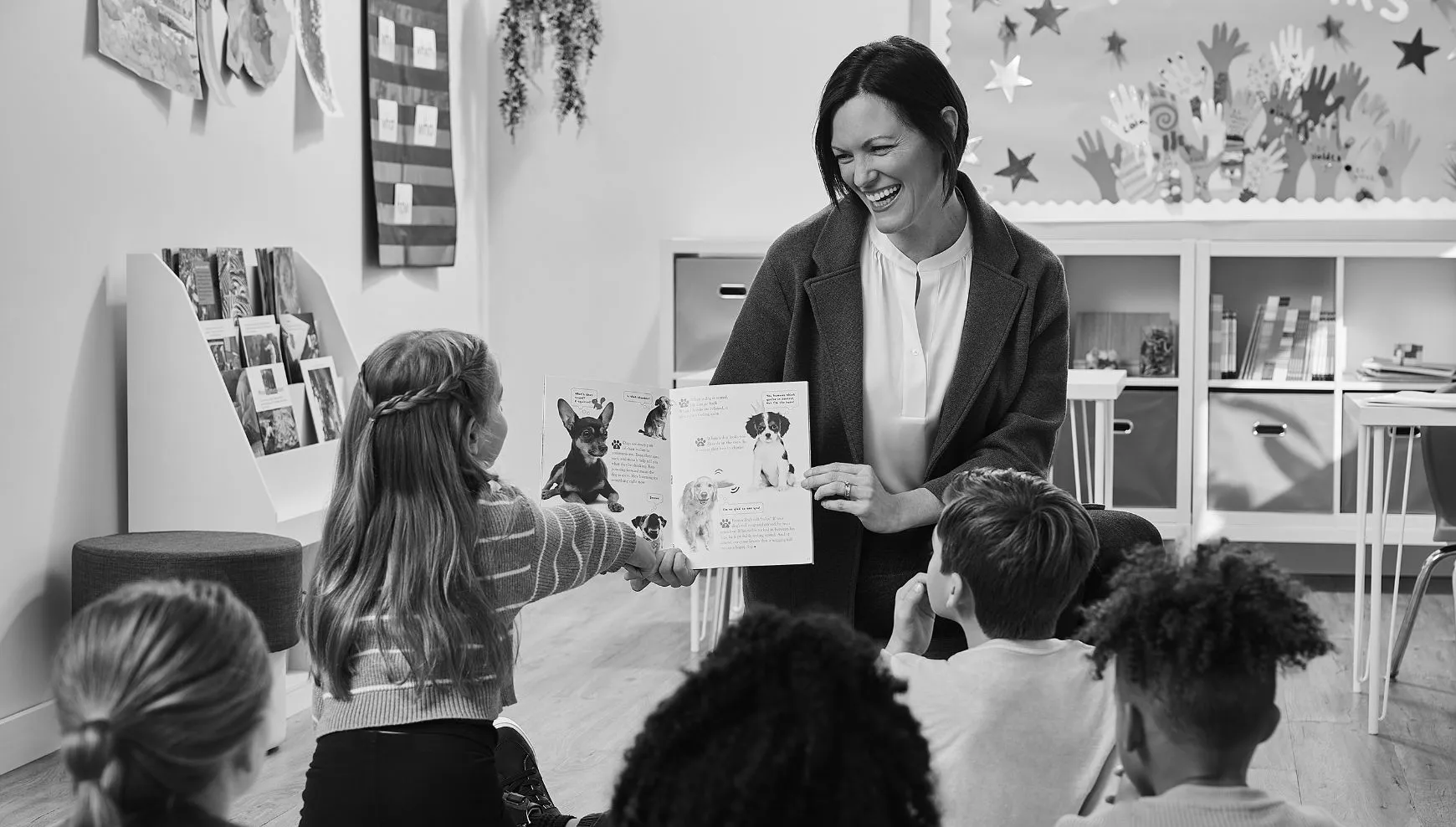
Building Language Comprehension for Readers in Grades K–2
Scientific research highlights the instructional components that build language comprehension. In this white paper, Dr. Molly Ness examines the subskills of language comprehension and provides implications for instruction.
Download as a PDF
You’re about to see a word that—unless you are a crossword puzzle devotee—is likely unfamiliar to you. Ready?
aglet
You likely were able to decode it using your phonics skills, or perhaps you used an analogy approach (e.g., “If I know bag, I know ag.”) Now, how would you fare if I asked you to use that word in a sentence or to describe an aglet? It’s probably more challenging, correct?
Defining Language Comprehension
You’ve just seen evidence of the importance of language comprehension, the ability to make sense of spoken or written language. More specifically, reading researchers Wesley Hoover and William Tunmer (2022) define language comprehension as “the ability to extract and construct literal and inferred meaning from linguistic discourse represented in speech.” Let’s unpack the specifics of language comprehension, as well as practical implications for today’s K–2 classrooms.
“[Language comprehension is] the ability to extract and construct literacy and inferred meaning from linguistic discourse represented in speech.”
—Hoover & Tunmer, 2022
The Multiple Components of Language Comprehension
Let’s first begin with understanding the importance of language comprehension in overarching reading development. The Simple View of Reading (Gough & Tunmer, 1986) posits that reading comprehension is the product of two independent components: word recognition (the skills essential to identify and read words) and language comprehension (the skills needed to understand their meaning). Note that because this is a multiplicative equation, the overall outcome is dependent on the strength of both factors.

We can examine the Simple View of Reading with that now familiar word aglet. While you likely decoded it, you may lack the understanding of its meaning, usage, application, and context. In other words, you lack the language comprehension skills of this new word. In case you were wondering, an aglet is the tip of your shoelace (often wrapped in plastic or metal).

Another way to depict the many subskills that contribute to language comprehension is Hollis Scarborough’s (2001) Reading Rope.

This illustration reminds us that as a reader’s word identification skills (lifting words off the page through phonological awareness, decoding, and phonics) should be fluent, while the many strands of language comprehension contribute to purposeful reading. The subskills within language comprehension intertwine, enabling readers to make sense of what they read.
Each of the subskills of language comprehension can be well understood through the research and has implications for instruction. We begin first with background knowledge, followed by an examination of each of the remaining strands of language comprehension.
Background Knowledge
Of the many subcomponents of language comprehension, background knowledge has arguably received the most attention recently, both because of the publication of mainstream books such as The Knowledge Gap (Wexler, 2019), literacy scholars and advocates (Knowledge Matters Campaign, 2022), and curriculum developers.
Knowledge can be defined as “the sum of individuals’ existing knowledge, including personal, domain, topic, strategic, social, cultural, and linguistic knowledge” (Hattan & Lupo, 2020). In other words, it is much more than what one knows about topics like ancient Mesopotamia, cellular division, or the water cycle. Background knowledge also entails the cultural nuances that help us navigate our worlds and communities, the experiential knowledge which supports understanding of texts and the world.
“[Knowledge can be defined as] the sum of individuals’ existing knowledge, including personal, domain, topic, strategic, social, cultural, and linguistic knowledge.”
— Hattan & Lupo, 2020
Research indicates that though knowledge building and activation should occur continuously throughout reading, it largely occurs prior to reading (Hattan & Alexander, 2020). Background knowledge allows readers to make inferences throughout the text, to unpack inferential meaning, to make sense of unfamiliar words, to process information more effectively, and to better connect to what they read.
- Cultural knowledge: If I were to meet a new person in the United States, I might shake their hand, but if I were in Japan, I might bow to them.
- Linguistic knowledge: I speak in a more formal way to my boss, versus my best friend.
- Social knowledge: I wait at the end of a line at the grocery store for my turn to check out.
- Use short video clips and/or images to build knowledge prior to a topic. For instance, prior to a read aloud of In the Trees, Honeybees: A Rhyming Nature Book for Kids by Lori Mortenson, show pictures of honeycombs and beehives.
- Intentionally connect the knowledge across text sets. For example, if embarking upon a unit about animals, remind students that, “In our previous book Shark Lady, we learned how scientists study animals so that they don’t become endangered. In our next book, A Boy and a Jaguar by Alan Rabinowitz, we are going to explore another animal that might become endangered.”
- Be mindful that knowledge building and activation should occur not only prior to read alouds, but during read alouds as well. Hattan, Alexander, and Lupo (2024) remind us that “before-, during-, and after-reading activation techniques were beneficial for students’ comprehension, yet during-reading supports seemed to be particularly useful.”
Vocabulary Knowledge
Let’s go back to that word aglet. As it is not a commonplace term, no doubt you struggled to define it, use it, and apply it. We’ve just seen a demonstration of how unfamiliar vocabulary detracts from language comprehension. Research demonstrates that word meaning accounts for as much as 80% of reading comprehension (Nagy & Scott, 2000). Even more compelling is longitudinal research from Anne Cunningham and Keith Stanovich (1997). They gave first graders a series of literacy measures—including vocabulary—and found that vocabulary knowledge in grade one predicted reading achievement and comprehension for those same students in high school!

Vocabulary, however, is much more than merely knowing the definition of a word; Charles Perfetti (2007) proposed the lexical quality hypothesis to differentiate between the words that a reader knows well versus those with a shakier understanding. The more that a reader knows about the word’s phonology (sound structure), orthography (written representation and spelling), and semantics (meaning, usage, and grammatical form), the deeper the lexical quality. This reminds us that simply teaching a word’s definition does not improve children’s ability to use that word and know it deeply. Further, observational studies in early childhood classrooms indicate that vocabulary instruction largely consists of word explanations, without more formal vocabulary instruction (Wright, 2012).
- Rather than having students look up words in dictionaries, provide them with a student-friendly definition of the word: one that is straightforward and concise, uses everyday language, and builds upon information that they already know.
- When encountering new words, use this following instructional sequence: Say the word, have students repeat the word, conduct basic word study around the word (count/mark up its syllables, connect phonemes to graphemes), define the word for students, connect the definition to how the word appears in the text, and lead students through multiple vocabulary interactions after reading.
- Teach words that are related to each other. For example, if teaching the word famished, you might define it as “famished is another way to say hungry.” Teach related words like ravenous and starving.
- Provide multiple engaging ways to interact with the word over several days. Have students sketch the word, act it out, and think of examples and non-examples.
Language Structures
Language structures in Scarborough’s rope refer to both semantics and syntax. While semantics pertains to word choice, syntax is more than just grammatical structure. Syntax includes word order, sentence structure, and the rules and conventions that give structure and organization to our language; a recent article (Lupo, Reynolds, & Hardigree, 2025) explains that syntax refers to how easily readers can interpret complex sentence structures. Supporting students in language structure entails much more than having them diagram sentences or note a word’s part of speech. It also includes highlighting how the inclusion, meaning, or order of one word can alter the entire meaning of a text. More specifically, the syntactic structure of English is for an adjective to precede a noun (e.g., a blue car). Other languages—such as Spanish—place the adjective after the noun (e.g., un coche azul). Syntax also enables readers to understand that though the two sentences below look quite similar, the word order drastically influences their meanings:
I eat only pizza.
Only I eat pizza.
Another language structure that is often a source of confusion for students is the inclusion of independent and dependent clauses, as demonstrated in the sentence below:
The girl standing next to the woman was wearing a green shirt.
When asked “Who was wearing the green shirt?”, many students provide the woman as their response, not understanding the role of the dependent clause. Syntax also includes ambiguous pronouns (e.g., it, they), cohesive devices (words that refer to earlier antecedents, such as how she and her refer to a previously named character), and connectives (e.g., so, because, but) (Castles, Rastle, & Nation, 2018).
- Model syntax in shared writing instruction. Intentionally point out, “I am writing the adjective before the noun in our sentence about picking orange pumpkins on our field trip.”
- Use sentence strips to cut up sentences and model putting them into the correct syntactic order.
- So that students understand connections between words, teach vocabulary through semantic relationships. For instance, if reading aloud from Shark Lady (where the protagonist is a curious scientist), lead students in semantic gradients—ranking new and semantically related words like inquisitive, probing, and scrutinizing.
- Ensure classrooms are rich with oral language and discourse. Expect very young children to speak in complete sentences, and/or model how to turn their short responses into more semantically complete sentences.
Verbal Reasoning
Much of the meaning that readers make from text is inferred or implied, rather than literally stated. Verbal reasoning enables readers to move beyond literal meaning and make more sense of a text through deeper understanding (Burton et al., 2009). Through verbal reasoning, children make logical inferences, integrate ideas within different parts of a text or between related texts, and interpret abstract language. As defined by O’Brien and colleagues (2015), inferences enable readers to “integrate information within the text and between the text and one’s general knowledge of the topic to understand ideas not explicitly stated in the text.” Consider the following sentence:
Luke took a spoonful of his dinner and smiled in delight.
A skilled reader will infer that Luke is satisfied with the contents of his dinner or is smiling because his meal is delicious. Research (Rice & Wijekumar, 2024) has determined that explicit instruction in inference is beneficial to students. Verbal reasoning also includes a reader’s ability to decipher the meaning of metaphors, analogies, idioms, and other types of figurative language. How might your students make sense of the following phrases?
It takes one to know one.
The night before the exam, the students hit the books.
That book was a roller coaster ride of emotions.
They fought like cats and dogs.
- Include an example of figurative language at the end of every morning meeting. Read it with students and model how you unpack it to make sense of it.
- Create classroom dictionaries of the figurative language that you’ve encountered.
- Use think alouds (first-person narrative language) to model inferences as you read aloud. Use sentence starters such as, “The author doesn’t come right out and tell me, but I’m getting the sense…” or “From what I know and the clues in the text, I’m thinking that…”
Literacy Knowledge
The final strand of language comprehension—literacy knowledge—encompasses a student’s knowledge of navigating skillfully through a text. For beginning readers, this involves the rudimentary pre-reading skills of turning pages and reading top to bottom, left to right. As students mature, they develop more advanced skills, like navigating the text features of a nonfiction book to efficiently find information.

Skilled readers have rich literacy knowledge, understanding of the purposes, features, and conventions of texts. They navigate through an informational text differently than they approach a narrative picture book. We cannot overlook the value of teaching text structure and organization as a way to promote comprehension (Bogaerds-Hazenberg et al., 2021). In fact, long-standing research (Meyer, 1975) confirms that most texts follow one or more of the following predictable structures: sequence, description, comparison, problem/solution, and cause/effect. Students may benefit from previewing the text structure prior to rereading (e.g., skimming the subtitles and graphic features) and using the text structure to enable them to summarize a text (Hudson et al., 2021).
We cannot overlook the value of teaching text structure and organization as a way to promote comprehension (Bogaerds-Hazenberg et al., 2021).
- Use familiar text to build students’ understanding of text structure, in conjunction with story maps and other graphic organizers (Shanahan et al., 2010).
- Model using informational text structures and signal words to build students’ comfort with various text elements and features (Shanahan et al., 2010).
- With beginning readers, use big books to model and draw attention to concepts of print and foundational literacy knowledge (e.g., finger sweep at the end of the line, print directionality).
Putting It Together for K–2 Instruction
A robust body of research—known as the science of reading—highlights the instructional components that build both foundational word recognition and language comprehension skills in early childhood classrooms. Essential in these grades is explicit instruction, which the Florida Center for Reading Research defines as when “the teacher defines and teaches a concept, models the learning process, guides students through its application, and arranges for extended guided practice until mastery is achieved.” In explicit instruction, nothing is left up for student guessing or discovery; instead, teachers are direct, clear, and intentional in teacher-led instruction. Teachers’ actions are visible, as is what students are to do and to learn.

A long-standing tradition in many early childhood classrooms, teacher-conducted read alouds are essential in building language comprehension. In a read aloud, students and teacher interact over a shared text, with an essential exchange of language. A rich body of research (Ness, 2024) confirms the academic, linguistic, and socioemotional benefits of read alouds; however, read alouds require intentional planning to maximize language comprehension. A key component of read alouds is high-quality text, both nonfiction and fiction. High-quality texts include sophisticated vocabulary opportunities, provide knowledge for students across multiple content areas, and jump-start oral language interactions between students and their teachers.
We are at an exciting time in our nation’s literacy landscape, where there is a sense of urgency about the implementation of the science of reading. Advancing literacy rates and enjoyment for our children requires intentional instruction of both word identification skills and language comprehension. Through intentional instruction loaded with rich discourse around engaging text, we build super readers who read with skill, purpose, and passion.
About the Author

In 2024, Dr. Ness was invited to serve on the New York State Dyslexia Task Force. A frequent speaker and presenter, her happy place is translating the science of reading to schools and teachers. As a tireless literacy advocate, Dr. Ness created the End Book Deserts podcast, which brings awareness to the 32 million American children who lack access to books. When she is not reading and writing about reading and writing, Dr. Ness is driving her ice-hockey obsessed teenage daughter to the rink, learning how to fly fish, or hiking with her poorly behaved goldendoodle.
References
Bogaerds-Hazenberg, S. T., Evers-Vermeul, J., & van den Bergh, H. (2021). A meta-analysis on the effects of text structure instruction on reading comprehension in the upper elementary grades. Reading Research Quarterly, 56(3), 435–462.
Burton, N.W., Welsh, C., Kostin, I., & van Essen, T. (2009).Toward a definition of verbal reasoning in higher education. Princeton, NJ: ETS. Retrieved from https://files.eric.ed.gov/fulltext/ED507807.pdf.
Castles, A., Rastle, K., & Nation, K. (2018). Ending the reading wars: Reading acquisition from novice to expert: Corrigendum. Psychological Science in the Public Interest, 19(2), 93.
Cunningham, A. E., & Stanovich, K. E. (1997). Early reading acquisition and its relation to reading experience and ability 10 years later. Developmental Psychology, 33(6), 934–945.
Florida Center for Reading Research. (2023). Florida practice profiles: Explicit instruction. Retrieved from https://fcrr.org/educators/florida-practice-profiles.
Gough, P. B., & Tunmer, W. E. (1986). Decoding, reading, and reading disability. Remedial and Special Education, 7, 6–10.
Hattan, C. & Alexander, P. (2020). Prior knowledge activation in elementary classroom discourse. Reading and Writing, 33(6), 1617–1647.
Hattan, C., Alexander, P. A., & Lupo, S. M. (2024). Leveraging what students know to make sense of texts: What the research says about prior knowledge activation. Review of Educational Research, 94(1), 73–111.
Hattan, C. & Lupo, S. (2020). Rethinking the role of knowledge in the literacy classroom. Reading Research Quarterly, 55(51), 283–298.
Hoover, W. A., & Tunmer, W. E. (2022). The primacy of science in communicating advances in the science of reading. Reading Research Quarterly, 57, 399–408.
Hudson, A. Owens, J. Moore, K., Lambright, K., & Wijekumar, K. (2021). What’s the main idea?: Using text structure to build comprehension. The Reading Teacher, 75(1), 113–118.
Knowledge Matters Campaign. (2022). Knowledge matters campaign. Retrieved from https://knowledgematterscampaign.org.
Lupo, S. M., Reynolds, D., & Hardigree, C. (2025). Tackling tough texts: A research-based guide to scaffolding learning in grades 6–12. New York, NY: Guilford Press.
Meyer, B. J .F. (1975). The organization of prose and its effects on memory. North-Holland: Amsterdam, The Netherlands.
Nagy, W. E., & Scott, J. A. (2000). Vocabulary processes. In M. L. Kamil, P. B. Mosenthal, P. D. Pearson, & R. Barr (Eds.), Handbook of reading research, Vol. 3 (pp. 269–284). Mahwah, NJ: Lawrence Erlbaum Associates Publishers.
Ness, M. (2024). Read alouds for all learners: A comprehensive plan for every subject, every day, grades preK–8. Bloomington, IN: Solution Tree.
O’Brien, E. J., Cook, A. E., & Lorch, J. R. F. (2015). Inferences during reading. Cambridge, U.K.: Cambridge University Press.
Perfetti, C. (2007). Reading ability: Lexical quality to comprehension. Scientific Studies of Reading, 11(4), 357–383.
Rice, M. & Wijekumar, K. (2024). Inference skills for reading: A meta-analysis of instructional practices. Journal of Educational Psychology, 116(4), 569–589.
Scarborough, H. S. (2001). Connecting early language and literacy to later reading (dis)abilities: Evidence, theory, and practice. In S. Neuman & D. Dickinson (Eds.), Handbook for research in early literacy (pp. 97–110). New York, NY: Guilford Press.
Shanahan, T., Callison, K., Carriere, C., Duke, N. K., Pearson, P. D., Schatschneider, C., & Torgesen, J. (2010). Improving reading comprehension in kindergarten through 3rd grade: A practice guide (NCEE 2010-4038). Washington, DC: National Center for Education Evaluation and Regional Assistance, Institute of Education Sciences, U.S. Department of Education. Retrieved from whatworks.ed.gov/publications/practiceguides.
Wexler, N. (2019). The knowledge gap: The hidden cause of America’s broken education system—and how to fix it. New York: Penguin Random House.
Wright, T. (2012). What classroom observations reveal about oral vocabulary instruction in kindergarten. Reading Research Quarterly, 4(12), 353–355.